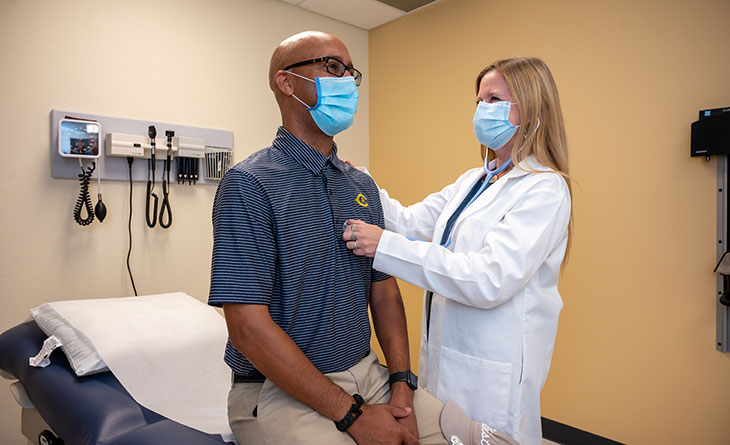Recognizing the Important Role of Medical Care in Comprehensive Wellness Management and Condition Avoidance Methods
The important duty of medical care in thorough wellness monitoring and illness avoidance methods can not be overstated, as it acts as the structure for efficient healthcare distribution. By prioritizing preventive care and promoting long-lasting patient-provider connections, medical care specialists are distinctively placed to deal with specific health requirements while additionally affecting wider area health results. The complexities and challenges faced in the application of these methods increase essential questions about how best to optimize primary care's efficiency. What ingenious techniques might improve its effect on both specific and public wellness?
Meaning of Health Care
Although the concept of key treatment might differ across different healthcare systems, it fundamentally describes the first point of call for individuals within the medical care continuum. Key treatment incorporates a wide variety of services, consisting of preventive treatment, diagnosis, therapy, and administration of chronic problems. It is characterized by its comprehensive, obtainable, and collaborated approach, making sure clients obtain holistic treatment tailored to their specific needs.
Main care companies, often family doctor, internists, or doctors, play an essential duty in establishing ongoing patient-provider connections. This continuity of treatment fosters depend on and helps with far better health end results with regular tracking and tailored treatments. The emphasis on a patient-centered technique enables the consideration of social, financial, and emotional aspects that influence wellness.
Moreover, primary treatment acts as an important component in browsing the healthcare system, assisting patients with specialized solutions when necessary. By functioning as a main hub for health administration, medical care not only addresses prompt clinical worries yet also highlights the relevance of total wellness and safety nets. Thus, its definition prolongs past mere treatment to include a thorough framework for health promotion and condition avoidance.
Benefits of Preventive Treatment
Precautionary care deals many benefits that dramatically boost specific and area wellness results. By focusing on the prevention of diseases and health concerns prior to they develop, precautionary care decreases the incidence of serious wellness problems, consequently lowering healthcare prices gradually. Early detection through normal testings and evaluations permits prompt interventions, which can prevent the development of illness, causing enhanced lifestyle for patients.
In addition, precautionary care promotes wellness education and learning and awareness, encouraging people to make educated choices concerning their way of lives and health and wellness habits. This proactive technique urges routine check-ups, inoculations, and health and wellness screenings, which not only profit individuals yet likewise contribute to the total wellness of the area. By decreasing the burden of persistent diseases and avoiding outbreaks of infectious illness, precautionary care plays a critical function in boosting public health.
Along with boosting private wellness outcomes, precautionary treatment fosters a much more reliable health care system by decreasing the need for substantial therapies and hospitalizations. Eventually, purchasing precautionary treatment is important, as it promotes healthier populaces, decreases health and wellness differences, and guarantees far better resource allotment within the medical care system.
Role in Persistent Condition Administration
The proactive strategies used in preventive treatment contribute in the monitoring of chronic conditions, which commonly need ongoing interest and resources. Health care service providers play an essential why not try here role in this context, functioning as the very first point of get in touch with for people with persistent conditions such as diabetes, hypertension, and cardiovascular disease. They are critical in creating customized management plans that encompass regular monitoring, medicine administration, and way of life alterations.

Moreover, medical care providers typically utilize innovation and information analytics to track individual development and recognize potential issues early. This aggressive surveillance enhances person engagement and empowers individuals to take an energetic duty in their wellness monitoring. Inevitably, the assimilation of key treatment into persistent condition monitoring promotes enhanced high quality of life and decreases the concern on healthcare systems.
Patient-Provider Relationships

Moreover, a robust patient-provider rapport enhances patient engagement and self-management. Suppliers that spend time in recognizing their people' backgrounds, preferences, and motivations are better equipped to support them in managing their problems. This personalized approach can lead to improved health outcomes, as clients are much more likely to comply with suggestions when they really feel valued and recognized.
Additionally, continuity of care plays a considerable duty in enhancing these connections. Normal communications in between people and providers facilitate ongoing evaluation and modifications to treatment plans, which is vital for handling chronic diseases efficiently. This continuity not just advertises much better health end results yet additionally minimizes health care costs by minimizing the demand for immediate interventions.
Impact on Neighborhood Health And Wellness
Strong patient-provider relationships dramatically influence community wellness end results, as they add to a more involved and notified population. rhino virus. When clients feel attached to their medical care carriers, they are more probable to look for preventive solutions, adhere to therapy plans, and join health-promoting habits. This engagement promotes a culture of wellness, where individuals prioritize their health and wellness and the well-being of their neighborhood
Moreover, effective communication between patients and suppliers their explanation boosts health literacy, encouraging individuals to make informed choices concerning their treatment. This raised understanding can result in decreased prices of chronic conditions, as individuals come to be aggressive in managing their health and wellness. Furthermore, solid relationships promote the identification of community-specific health challenges, allowing providers to customize interventions that resolve local requirements.
Furthermore, health care works advice as an essential gain access to point for health and wellness sources, connecting people with necessary services and assistance networks. This thorough approach not only improves private wellness but likewise reinforces neighborhood communication, as residents work collaboratively to address wellness differences. On the whole, the influence of durable patient-provider relationships expands past the clinic, promoting much healthier areas and adding to a sustainable health care system.
Verdict
In recap, health care is essential to reliable health monitoring and illness prevention. By emphasizing preventative care and chronic condition monitoring, primary care promotes very early discovery and tailored therapy plans. Solid patient-provider connections foster trust fund and improve adherence to health and wellness recommendations. Ultimately, the integration of medical care into area wellness approaches brings about boosted health end results and reduced healthcare costs, underscoring its essential role in promoting total area well-being.